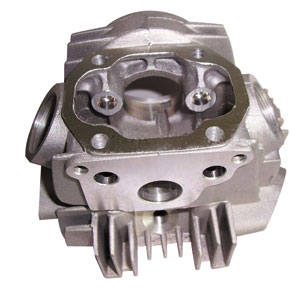Cylinder-head Production in China Held Back by Small-sized Operations
2009/10/08 | By CENSThe development of automotive cylinder-head production in China has been remarkable and rapid, but some problems also have emerged to compromise its steadfast continuation in the future: Most manufacturers in China, likely due to availability of cheap but relatively unskilled labor, focus on labor-intensive production so output capacity and technology-intensive production lag those in industrially advanced nations, where automation and well-trained machinists are emphasized; high energy-consumption due to lack of know-how and availability of energy-efficient machinery and practices; low production efficiency due to lack of formal training and expertise; high environment pollution due to apathy and extra cost incidental to installing eco-friendly facilities; and high consumption of natural resources due to inadequate use of recycled materials.
In addition, a common plight among the manufacturing sector in China is operating scale. Most cylinder-head makers in China are relatively small, which tend to breed typical size-related weaknesses as lack of technical-innovation capability and poor corporate management, obstacles that block business advancement.

However, some Chinese cylinder-head makers have been trying to improve product design and manufacturing capability to meet the latest global trends.
One such technical improvement in cylinder-head design is to upgrade airflow efficiency by designing fuel-flow passages inside cylinder heads to achieve optimal volumetric efficiency. In the past, industry sources say, most designers compromised airflow efficiency by adapting air passages around cylinder-head nuts and bolts, cooling fluid ducts etc. to minimize overall cylinder-head height so engines would fit under hoods. Not until recently, they add, have designers of high horsepower engines begun to prioritize the configuration of airflow passages, trying to achieve optimal geometry to create fast, straight airflow for the best volumetric efficiencies.
Most Chinese cylinder-head makers have other goals in mind. They often prioritize locating other key parts in cylinder heads, leaving the decision on locations of airflow ports till the final stage of the product design. One reason for such decision-making might be driven more by the bottom-line than performance: The designers aim to maximize profit-making cycles of older engine designs, hence minor modifications are made rather than starting over or making innovative changes. They take literally the path of least resistance: Chinese makers often "improve" airflow by enlarging ports, as well as porting to maximize, smooth airflow. Such attempts may seem logical but improving cylinder-head performance is likely much more complex than that. The typical path to upgrade engine performance involves enormous investment in technology, manpower and equipment, as well as trial by experimentation and racing.
Bench Work Critical
To better understand and improve air intake and exhaust of cylinder heads, designers must devote ample time on airflow benches to measure airflow to discover possible techniques to maximize airflow in a cylinder head. An effective cylinder-head designer will try to achieve maximum airflow volume by minimizing air-volume expansion, as well as prioritizing airflow speed and equaling volume of air/fuel mixture to every cylinder. In most cases, designers have their own know-how to find the optimal balance between the most compact cylinder-head, highest airflow speed, and biggest airflow volume.
Professional racing teams in major international events as NASCAR, CART, NHRA or F-1 keep confidential the design of cylinder heads' intake/exhaust ports. Such designs of cylinder heads run by various professional racing teams, however, are not achieved by mathematical formulas but by airflow bench work, engine dynamometers, and tuning based on feedback from racing.
Latest Improvement
The latest technical development to improve cylinder-head performance is the precision machining of engine valves, which can upgrade airflow efficiency by 50%. The basic method is to machine valve seats to a targeted angle (45-degree for example) or peripheral areas close to valve seats to optimize the angle of airflow to valves.
Generally, the valve machining for high-performance engines consists of three major steps: Machining intake valves to 60-to-70 degrees to optimize airflow to the 45-dgree geometry of valve seats; machining valve seats to 45-degree to optimize sealing in cylinders; and machining valves about 5-degrees to smooth intake/exhaust airflow.
Another potential way to upgrade engine performance is to decrease diameter of valve stems. Reducing valve-stem diameters even slightly can effectively increase airflow volume through intake/exhaust ports, but also weakening mechanical strength of valve stems. Yet another way to improve airflow smoothness of valves is to rifle engine valves, which can reduce airflow density, achieving the same effect as eddies that can cut resistance in surface airflow.
The above-mentioned ways to improve cylinder heads and engine valves can effectively achieve better fuel efficiency and overall engine performance.




